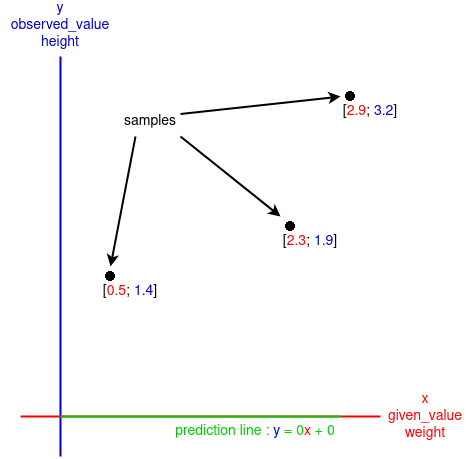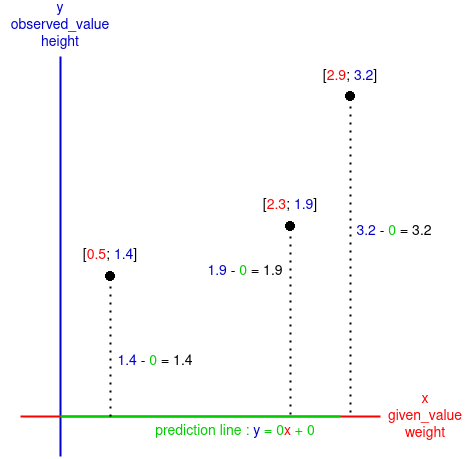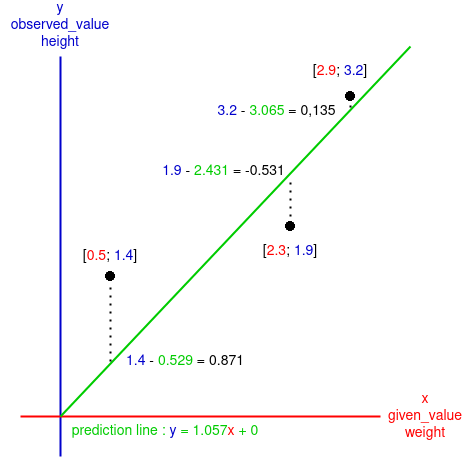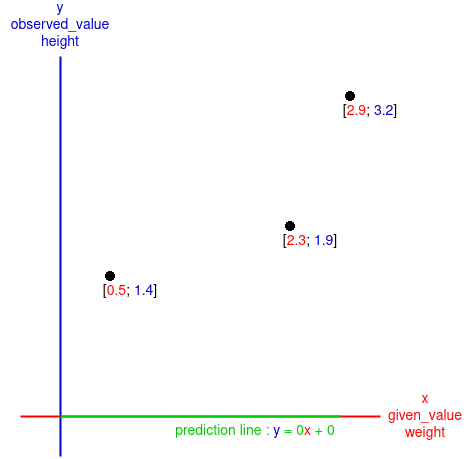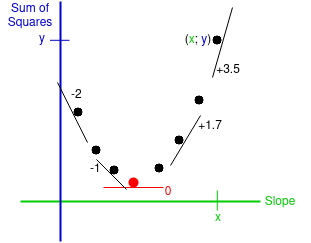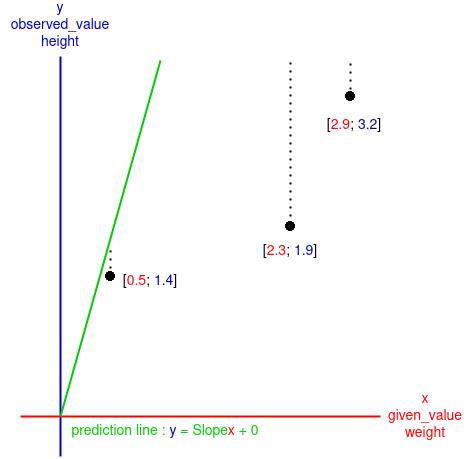The program here is the adaptation of Josh Starmer's video:
As I am blocking at coding the backpropagation algorithm in this video:

To be 100% sure of what is about gradient descent I will try to explain it.
But I will also try to make some hypotheses of what should be added to the gradient descent algorithm to work in a neural network, at least the one in the video mentioned earlier...
The goal of gradient descent:
The goal of gradient descent is to determine the intercept and the slope of a "prediction line", here the line predict the
But the algorithm need some samples in order to have a grasp of how this line must look, in terms of intercept and slope, those sample are the given
First, the algorithm will have a given initial guess, those are stored in slope_intercept, there are initialised as two
With the guess value of the slope (
The goal of this algorithm is to change the position of the for each samples:
Now we know for each samples how much the
Note:
Sometimes the
If we make the sum of the difference we will get:
But that doesn't make sense because the result is lower than the difference between
The solution to this is to make sure the diffrences are positive by calculating the square of the negative one:
But we also need to calculate the square of positive differences to keep a sense of proportionality between the differences:
The sum of square for the main exemple:
Now that we have the
Note
In the calculation of the Gradient descent the
To be efficient we need to calculate the
As mentioned before we want to reduce as much as possible the sum of the differences between
To know which
Here we can see the lowest sum of differences,
So good so far we have found, theoretically, the best value for the
- This method could take an infinite amount of time if we don't choose how much we want the
$\textrm{\color{blue}Sum of Squares}$ to be near$0$ , in terms of numbers of$0$ after the decimal point,$0.\textrm{\color{blue}y}$ or$0.00\textrm{\color{blue}y}$ ? - Testing all the values of the
$\textrm{\color{green}Slope}$ to guess the lowest value of the$\textrm{\color{blue}Sum of Squares}$ would take a monstrous amount of time.
In Josh's video about gradient descent(link in the introduction) the number to represent how much we want precision_success.
If we want to reduce the number of tests to guess the
This variable is the derivative of the
Here we can see the lowest value of the
That mean more the derivative is far from
With the current exemple:
Note
Here a recape before calculating the derivative of
To calculate the
In a more generale way:
for i in 1..= N {
x = // can be any calculation that involve i
sum = x + sum;
}But if
for i in 0..= N - 1 {
x = // can be any calculation that involve i
sum = x + sum;
}With those info we can rewrite the formula of
But as
We will calculat the dérivatives of the
Here is the math to calculat the derivative of
We can't do it directly, we have to use the chain rule taking note that the
Since the derivative is with respect to the
And:
Note: Here
Finally:
Note: for
With the samples of the example :
The goal is to find a way to decreas this value until it's reach precision_success, 0.001.
The
But
This why there is something caled
Now we know how much we have to change the value of the
But should we add the
For now, the
If we want the
Since
Note
This also work if the value of
In that case we would like to lower the
We have the the new value of the
First we calculate the
Since the derivative is with respect to the
And:
Finally:
We can now calculate the
Then we use a
And finally we use the
The new formula of the
And we use this new
Here is a little gif to show the process in action:
Additional note:
Values were the good intercept and slope are found (approximately):
(note: the prediction line found by Josh is:
|
|
Learning rate slope, weight | Learning rate intercept, bias | number of try | prediction line |
|---|---|---|---|---|
|
|
|
|||
|
|
|
|||
|
|
|

